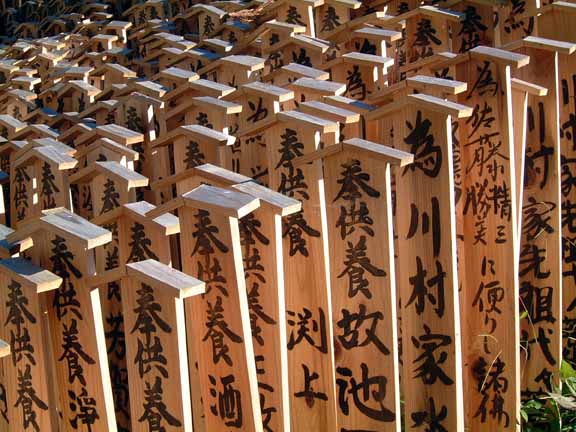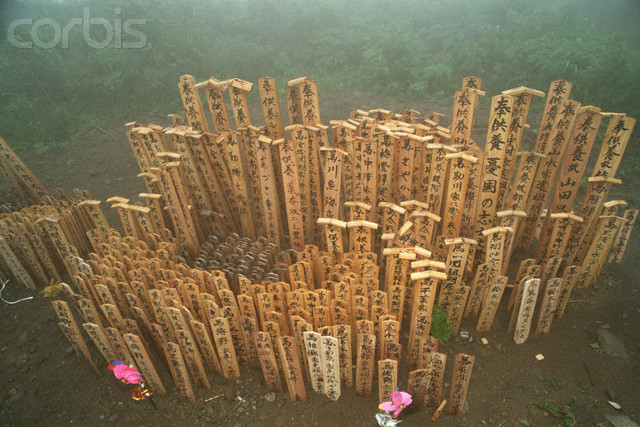This is part of an ongoing series about the Shinto way of death, adapted with permission from an academic article by Elizabeth Kenney. It shows how traditional Shinto arrangements differ from those of the Buddhist funeral. Though the research was carried out in the 1990s and some of the information is dated, the fundamentals still apply. For the original article, see Elizabeth Kenney ‘Shinto mortuary rites in contemporary Japan.’
****************
Posthumous names

Memorial tablets at Mt Haguro (courtesy orientalcaravan.com)
The Shinto dead, like their Buddhist colleagues, receive new names, but the Shinto postmortem sobriquet is not nearly as elaborate as the Buddhist kaimyô. In the Shinto case, the deceased keeps his ordinary name and a title is appended: mikoto or ushi no mikoto for men, and hime no mikoto or toji no mikoto for women. These terms sound like the appellations of Shinto deities and are meant to indicate that the deceased person has indeed become a kami.
The Shinto posthumous names are not only simpler than Buddhist kaimyô but cheaper. The Shinto name also has the practical advantage of preserving the name used in life, so there is no problem identifying the ancestors. To some Japanese people, the Buddhist posthumous name is an impenetrable string of expensive kanji that perpetuates status differences into the afterlife.
A book on how to produce one’s own funeral provides the following interesting example: “U-san, age 69, of Nagano Prefecture held a Shinto funeral for her husband. [She said,] ‘When my husband’s parents died, they received Buddhist kaimyô. However, my husband never really liked the kaimyo. He insisted that he didn’t need a kaimyô for himself, that he hated the smell of incense and so forth. So when he died, we had a Shinto funeral. In Shinto, there is no kaimyô, just a memorial tablet with your own name, saying So-and-so-no-mikoto “‘.
In the case of U-san and her husband, an antipathy toward Buddhism (the fact that the fragrance of incense repelled him is very telling) became crystallized in their rejection of the kaimyô. In this case, his parents’ kaimyô, which he didn’t like but had to live with until he died, came to symbolize Buddhist priests as domineering, insensitive, and greedy.
The Shinto funeral, in contrast, gave the family more control over their own posthumous destinies. For this family, Shinto, somewhat unexpectedly, was a liberating alternative, offering release from the grip of Buddhism.


This series has been really interesting! And I wonder if Shinto will ever embrace the relatively new practise of Tree-Burial, considering its focus on the natural world? https://themirrorbook.wordpress.com/2014/12/05/a-talk-on-japanese-tree-burials/
Yes, I wondered about that too, though I’m not sure we should expect flexibility from the Shinto orthodoxy…. From what I’ve read there’s a trend amongst secular Japanese to engage in ‘natural burials’ because they are not only cheaper and environmental, but free of ritual complications.
Fantastic site John. A treasure trove of information. Thanks!